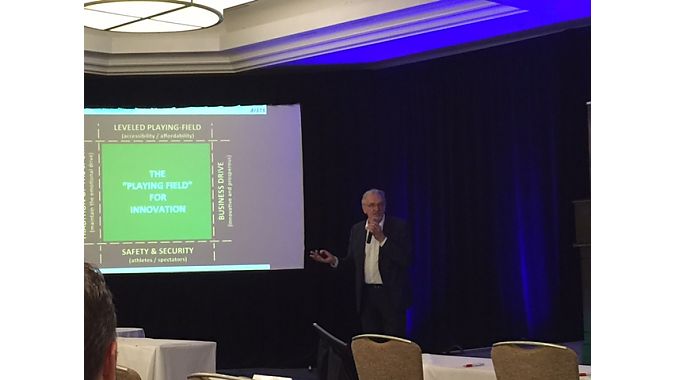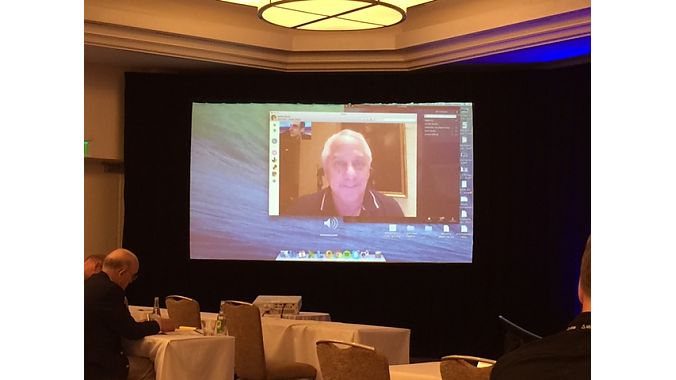NEWPORT BEACH, Calif. (BRAIN) — With a sharp focus on the use of composites in bicycles and cycling accessories — from materials selection and optimization to manufacturing processes, safety testing, repair and, ultimately, recycling — the second annual Cyclitech bike technology conference drew 145 industry engineers, presenters and sponsors to Southern California on Tuesday and Wednesday.
Co-organized by JEC Group, a composites trade organization, and the Society of Plastics Engineers (SPE), Cyclitech was held for the first time last year in Belgium, featuring speakers from several bike brands as well as the UCI, the conference’s official partner.
Cervélo’s Richard Matthews, who spoke this week on the durability of composite road racing bicycles, said the conference provides a much-needed forum for industry engineers to share knowledge and zero in on technical details.
“That really is the strength of this conference. I was at the first one last year in Belgium, and we need to have a forum where we can talk technically, engineer to engineer, without having the usual discussion about the marketing of products and things like that,” said Matthews, Cervélo’s engineering R&D manager.
The conference slate included speakers from Giro, Koroyd and Rolo Bikes, as well as an international field of scholars and representatives from the UCI and the International Olympic Committee. Topics included the challenges of simplifying UCI equipment regulations; lowering risks of severe head injuries through tougher helmet safety standards; non-destructive testing and quality control of bicycle parts; and trends in e-bike design.
Several composite material suppliers delivered technical presentations. TenCate Advanced Composites’ Jason Gabriel, for example, spoke about a rise interest in thermoplastic composites in industries like aerospace during his presentation on the toughness and performance of composite prepregs.
“The materials are improving as far as quality and consistency goes. There are big efforts to qualify them and get more usage. There’s more people fabricating with them than were doing it in the ’90s when the GT bikes and the K2 Animals and whatnot were out with those thermoplastic composites. It’s very focused on aerospace, but I think it could spread to other industries,” he said.
“With thermoplastics you’re basically heating up the material, shaping it and getting the heat out, so you can literally make a part in a minute.”
And new manufacturing processes like injection overmolding, whereby complex shapes can be made with very little hand layup, could bring new efficiencies to the bike industry, he added.
“I’d love to see this move into some part of cycling,” said Gabriel, a lifelong mountain biker. “I don’t know how and I don’t know when, but it seems to make a lot of sense, and I think it could add a lot of value and a lot of durability.”
Conference attendee Matt Cymanski, chief engineer for Dimond Bikes in Des Moines, Iowa, said a pair of presentations on hybrid materials, including a new ductile composite from startup company REIN4CED incorporating steel to deform on impact instead of breaking catastrophically, particularly caught his attention.
“I think it shows that people are starting to think about what else can we add into carbon fibers to make a better product. Innegra (a maker of high-performance yarn used with high-modulus carbon fiber) was also talking about some vibration-damping properties. Catastrophic failure is obviously a big problem, and we’d like to eliminate that, but I think there are other applications for it that in next few years will become prevalent,” Cymanski said.
Greg LeMond had been scheduled to deliver the closing keynote on the conference’s first day, but was unable to attend due to a family health emergency. However, the three-time Tour de France champion — who is ramping up a new company in Tennessee to produce high-volume, low-cost carbon fiber — received a hero’s welcome when he called in to the conference via Skype from Minneapolis on Tuesday night. He predicted that LeMond Composites, licensing technology from the Oak Ridge National Laboratory, will begin producing carbon fiber, initially targeting the automotive industry, within the next 16 months.
“We want to lead new ways in manufacturing to make (carbon fiber) more accessible. … I think the price of this carbon fiber will drive innovation in manufacturing. So the automotive companies are going to benefit, but so are all the consumer goods companies. We know that to get this carbon fiber out to more markets, we’ve got to figure out more manufacturing solutions,” he said.
And that includes bike manufacturers, LeMond added.
“My goal is to bring cost savings into the bike industry too — both for the fiber and the cost of manufacturing,” he said.
JEC Group and SPE announced that Cyclitech will return around the same time next year at a yet-to-determined location in Europe. The trade groups will also co-organize a new conference on composites in sporting goods — including hockey, racket sports and golf — in 2017.





